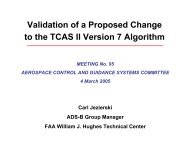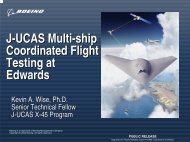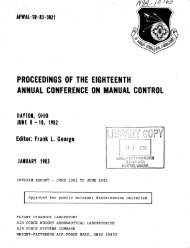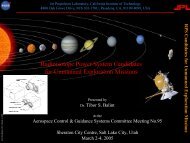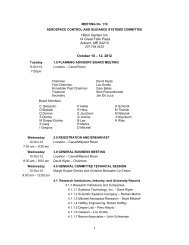Report of the Second Piloted Aircraft Flight Control System - Acgsc.org
Report of the Second Piloted Aircraft Flight Control System - Acgsc.org
Report of the Second Piloted Aircraft Flight Control System - Acgsc.org
Create successful ePaper yourself
Turn your PDF publications into a flip-book with our unique Google optimized e-Paper software.
second, at least to <strong>the</strong> proper order <strong>of</strong> magnitude. Thus, if we attempt<br />
to rid ourselves <strong>of</strong> <strong>the</strong> trouble with <strong>the</strong> relative or absolute instability<br />
<strong>of</strong> <strong>the</strong> hydraulic system by cutting down <strong>the</strong> bandwidth, we soon reach a<br />
point where <strong>the</strong> time <strong>of</strong> response <strong>of</strong> this part <strong>of</strong> <strong>the</strong> overall system becomes<br />
undesirably long. In one sense, this is indeed an unfortunate circumstance,<br />
since <strong>the</strong> bandwidth <strong>of</strong> this part <strong>of</strong> <strong>the</strong> system can simply be reduced by<br />
cutting down <strong>the</strong> gain, <strong>the</strong> bandwidth being r0ughJ.y proportional to <strong>the</strong> gain<br />
over <strong>the</strong> range <strong>of</strong> frequencies <strong>of</strong> interest to us.<br />
The second alternative for eliminating <strong>the</strong> undesirable effects <strong>of</strong><br />
coupling between two highl~ underdamged system--<strong>the</strong> flutter system and<br />
<strong>the</strong> hydraulic system--involves stabildnation <strong>of</strong> <strong>the</strong> hydrado system wNle<br />
maintaining <strong>the</strong> hi& gain essential for fast response. The diagram <strong>of</strong><br />
figure 5 indicates <strong>the</strong> difficulties involved here. As it now stands, <strong>the</strong><br />
hydraulic system is charact eristied by a transfer function-<strong>the</strong> Laplace<br />
transform <strong>of</strong> <strong>the</strong> ratio <strong>of</strong> <strong>the</strong> output over <strong>the</strong> input-with three polesone<br />
at <strong>the</strong> origin, and <strong>the</strong> o<strong>the</strong>r two a conjugate complex pair very close<br />
to <strong>the</strong> jw-axis. If we use <strong>the</strong> root-locus method <strong>of</strong> analysis we can see<br />
at once <strong>the</strong> effect <strong>of</strong> closing <strong>the</strong> loop with varying amounts <strong>of</strong> gain. In<br />
particular, we study what happens to <strong>the</strong> poles <strong>of</strong> <strong>the</strong> closed-loop transfer<br />
function <strong>of</strong> <strong>the</strong> hydraulic system as <strong>the</strong> gain is increased. For very low<br />
values <strong>of</strong> gain, <strong>the</strong> poles <strong>of</strong> <strong>the</strong> closed-loop system function are identical<br />
with those <strong>of</strong> <strong>the</strong> open-loop transfer function. As <strong>the</strong> gain is increased,<br />
<strong>the</strong> poles <strong>of</strong> <strong>the</strong> closed-loop system function move toward infinity, <strong>the</strong><br />
location <strong>of</strong> all <strong>the</strong> zeros <strong>of</strong> <strong>the</strong> open-loop function. The particular paths<br />
taken by <strong>the</strong>se poles as <strong>the</strong> gain is varied are shown in Fig. 6: one moves<br />
out from <strong>the</strong> ori- along <strong>the</strong> negative-real axis, <strong>the</strong> o<strong>the</strong>r two move away<br />
from <strong>the</strong> conjugate cornex pair <strong>of</strong> poles over into <strong>the</strong> right-half plane.<br />
For a relatively low value <strong>of</strong> gain, <strong>the</strong>se poles have crossed into <strong>the</strong> righthalf<br />
plane, indicating that <strong>the</strong> closed-loop system is unstable.<br />
How CM such a system be stabillzed? There are a variety <strong>of</strong> nays, im<br />
terms <strong>of</strong> <strong>the</strong> pole-zero loci, and <strong>the</strong>n a number <strong>of</strong> ways in which <strong>the</strong>se desired<br />
changes may be instrumented. We consider only one general method in any<br />
detail. The furdamental difficulty is <strong>the</strong> proximity <strong>of</strong> <strong>the</strong> conjugate poles<br />
to <strong>the</strong> jW ds. This arises because <strong>of</strong> <strong>the</strong> very sharp resonance betwem<br />
<strong>the</strong> compressibility <strong>of</strong> <strong>the</strong> <strong>of</strong>l and <strong>the</strong> mechanical and aerodynamical load.<br />
This resonance can be msde less sharp, and also incidentally moved to a lower<br />
frequency, if <strong>the</strong> compressibility <strong>of</strong> <strong>the</strong> oil can be effectively isolated from<br />
<strong>the</strong> load--in o<strong>the</strong>r words, if at <strong>the</strong> same time <strong>the</strong> expanding oil is giving <strong>the</strong><br />
piston an extra push, <strong>the</strong>re exists an alternate network which is absorbing<br />
this extra effective flow. One possible system for doing this is shown in<br />
fig. 7.<br />
Hare in Fig. 7 both <strong>the</strong> hydrauuc-mechanical system and <strong>the</strong> equivalent '<br />
electrical network are shown. In <strong>the</strong> equivalent circuit, <strong>the</strong> load corresponds<br />
to <strong>the</strong> series resonant circuit made up <strong>of</strong> LC, Rc, and Cc, repressnting<br />
respectively <strong>the</strong> mass, damping, and compUance <strong>of</strong> <strong>the</strong> aerodynamical and<br />
mechanical load. The oil compressibility is represented by <strong>the</strong> parallcondenser<br />
C. The resonance phenomena, speaking in electrical terms, ie



